|
|
Pyramid of Austerlitz
The Pyramid of Austerlitz is a 36-metre-high pyramid of earth, built in 1804 by Napoleon's soldiers on one of the highest points of the Utrecht Hill Ridge, in the municipality of Woudenberg, the Netherlands.[1] Atop the pyramid is a stone obelisk from 1894.
 An 1805 engraving of the Pyramid of Austerlitz by Louis-Pierre Baltard
In 1804, the French General Auguste de Marmont established an army camp (le Camp d'Utrecht) in this central location in the Batavian Republic, the present Netherlands, where over a period of several months he forged together various battalions into a large, well-trained army, capable of beating the British enemy should there be any repetition of the invasion of 1799. In the autumn of 1804, satisfied with the military power of the new army, and to occupy his bored soldiers, Marmont had his soldiers build an earth and turf monument inspired by the Great Pyramid of Giza, which Marmont had seen in 1798 during Napoleon's Egyptian campaign. Even the erosion-exposed stepped surface was imitated. Construction lasted 27 days. The pyramid hill was 36 metres (118 ft) high, and surmounted by a 13-metre (43 ft) wooden obelisk. It was named "Mont Marmont" or "Marmontberg".
In the summer of 1805, Marmont departed with his army to southern Germany to fight in the War of the Third Coalition, which culminated in the Battle of Austerlitz (now Slavkov u Brna), the battle in which Napoleon decisively defeated the Russians and Austrians.
In 1806, despite protests from Marmont, Louis Bonaparte, the new king of Holland, renamed the hill the Pyramid of Austerlitz, and gave the same name to the trading post at the nearby camp of Bois-en-Ville.
After leaving the Netherlands in 1805, Marmont gave the monument and the use of the nearby homestead Henschoten to three soldiers, Louis Faivre, Jean Baptiste La Rouche and Barend Philpsz, who were also to maintain the pyramid. Nevertheless, the wooden obelisk soon deteriorated, and was demolished in 1808. In 1816 the Marmont pyramid and its associated land were sold to the future mayor of Utrecht, Hubert MAJ van Asch van Wijk.
In 1894, Johannes Bernardus de Beaufort, who both owned the Henschoten estate on which the pyramid stood and was mayor of Woudenberg, had the current stone obelisk built on the pyramid. This also began to collapse.
 The Pyramid of Austerlitz in 2002, during its restoration
In view of its 200th anniversary in 2004, the highly dilapidated pyramid was restored between 2001 and 2004. This was done on the initiative of the province of Utrecht, the Den Treek-Henschoten estate and the municipality of Woudenberg, which had previously set up the Austerlitz Pyramid Foundation.
The very dry summer of 2003, followed by heavy rain in 2004, caused further subsidence, and restoration was resumed in 2007. The pyramid was reopened to visitors in 2008, along with a new visitor centre interpreting the period of French rule in the Netherlands. Further piling was carried out in 2010 and 2012 to stabilise the mound.
The Pyramid of Austerlitz is an inspiration for the larger Lion of Waterloo, the pyramid built by King William I as a monument to the Battle of Waterloo where Napoleon was defeated. The mound marks the spot where his son William II was injured.
The Pyramid is a national monument, monument number 39543.
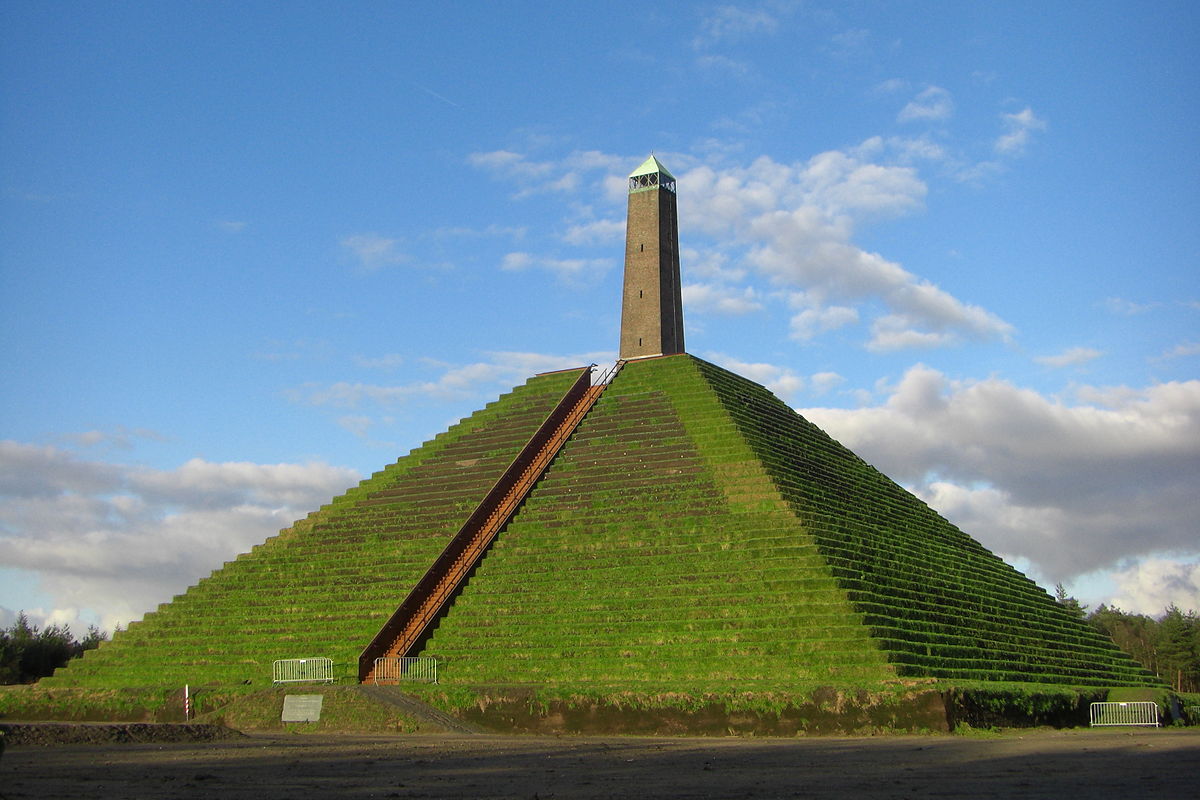 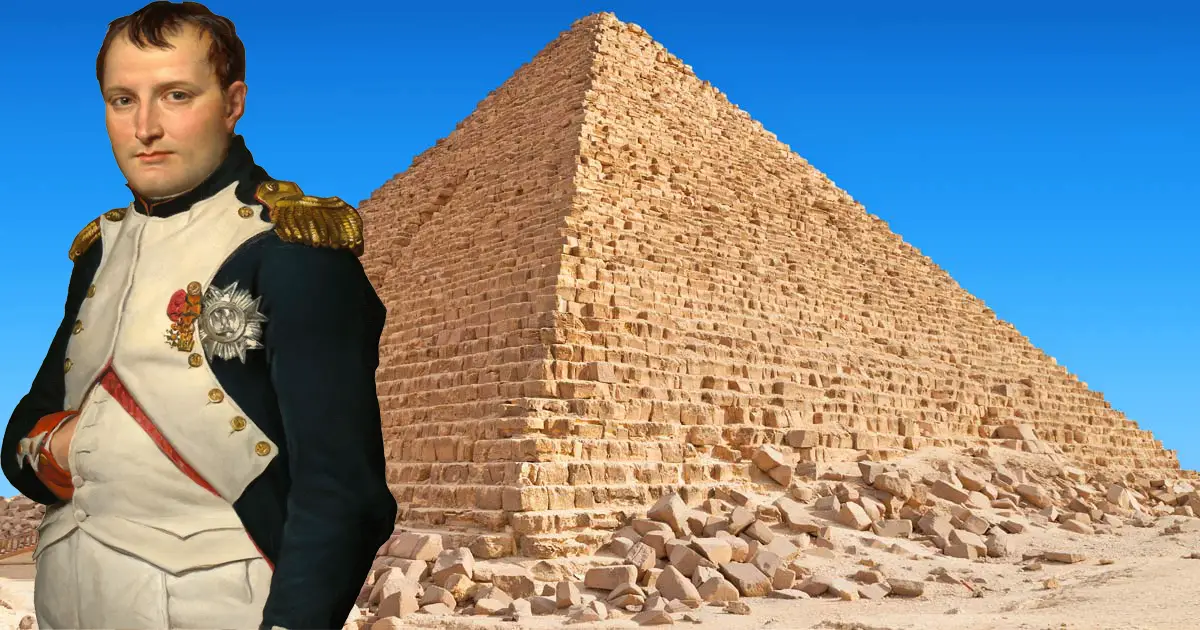   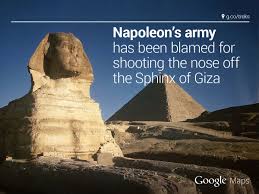
1/3-24/3 =24 DIAS
25/3-17/4=48 DIAS
18/4-11/5=72 DIAS
12/5-4/6 =96 DIAS=24*4
5/6-28/6 =120 DIAS (RADIAN=6.28)=24*5
29/6-22/7= 144 DIAS (DIA DE MARIA MAGDALENA 24X6)=HOLY WEEK/HOLY FRIDAY=24*6 REVELATION 21:17
23/7-15/8=168 DIAS (ASUNCION DE LA VIRGEN=227 GREGORIANO)=24*7
16/8-8/9 =192 DIAS =24*8
9/9-2/10= 216 DIAS =24*9
3/10-26/10=240 DIAS=24*10
27/10-19/11=264 DIAS=24*11
20/11-13/12=288 DIAS=24*12
14/12-6/1=312 DIAS=24*13 REYES MAGOS
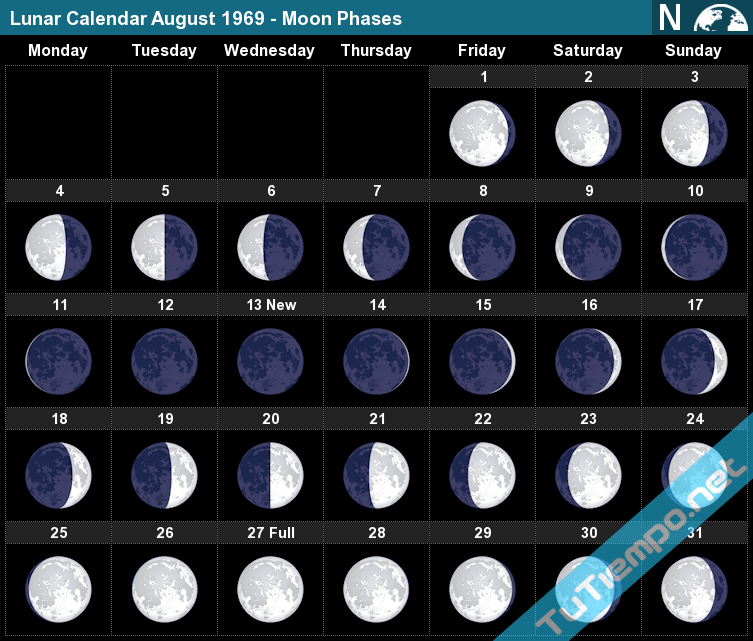
 August 13 New Moon 0% |
 August 14 Waxing Crescent 2%
|
August 15
Waxing Crescent
Illumination: 5% |
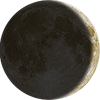 August 16 Waxing Crescent 10%
|
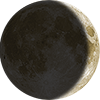 August 17 Waxing Crescent 17%
|
Moon Phase: August 15, 1969
On this day the Moon was in a Waxing Crescent Phase. Best seen in the west after the sun dips below the horizon at sunset. This is the first Phase after the New Moon and is a great time to see the features of the moon's surface. The moon is close to the sun in the sky and mostly dark except for the right edge of the moon which becomes brighter as the days get closer to the next phase which is a First Quarter with a 50% illumination.
Visit the August 1969 Moon Phases Calendar to see all the daily moon phase for this month.
Waxing Crescent Phase
The Waxing Crescent on August 15 has an illumination of 5%. This is the percentage of the Moon illuminated by the Sun. The illumination is constantly changing and can vary up to 10% a day. On August 15 the Moon is 2.11 days old. This refers to how many days it has been since the last New Moon. It takes 29.53 days for the Moon to orbit the Earth and go through the lunar cycle of all 8 Moon phases.
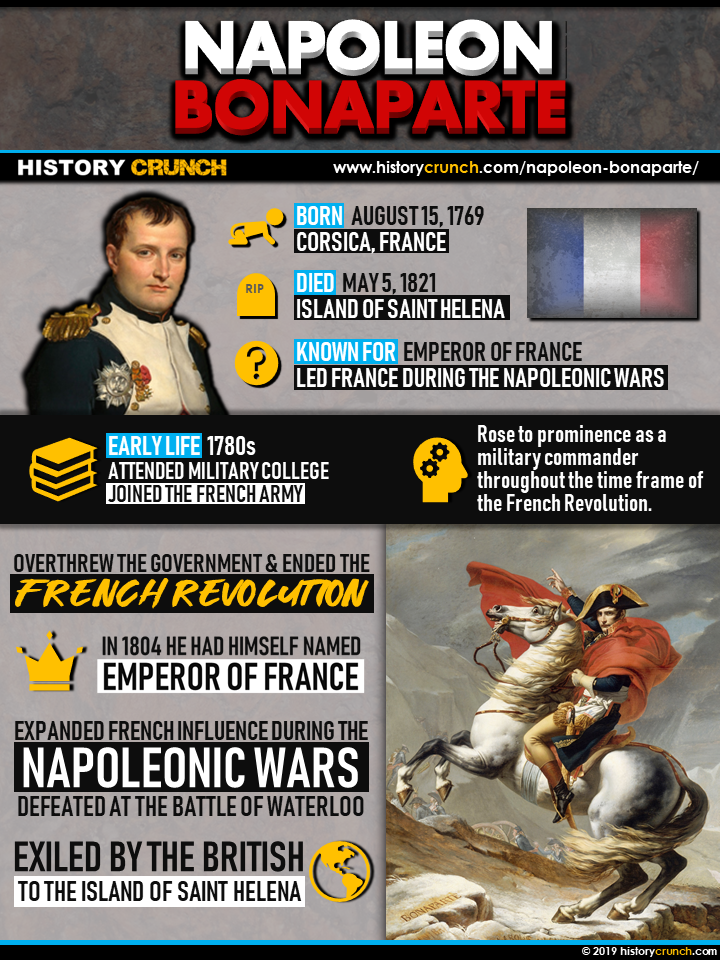
|
|
|
|
|
https://grillcollection.com/products/napoleon-16-apollo-200-charcoal-grill-3-in-1-smoker-and-grill |
|
|
|
|
I can recommend every amateur historian and Bonapartofile to read Jean-Baptiste Pérès. We chase dreams. Napoleon never existed. He’s fake news. A myth. Just like, say, Santa Claus, Homerus, William Tell, Robin Hood and King Arthur. Forget him.
I once bought Pérès’ essay “Comme quoi Napoléon n’a jamais existé” in French, that language of love, but found an English version today. For the busy Napoleonist, here’s the management summary of this brilliant satire.
Napoleon Bonaparte, of whom so much has been said and written, never even existed. He is nothing more than an allegorical personage. He is the personification of the sun ; and we can prove our assertion by showing how everything related of Napoleon the Great has been borrowed from the great luminary.
Let us see briefly what we are told of this remarkable man. We are told :
– That he was called Napoleon Bonaparte:
– That he was born in an island in the Mediterranean sea ;
– That his mother’s name was Letitia-;
– That he had three sisters and four brothers, three of whom
were kings;
– That he had two wives, one of whom bore him a son ;
– That he put an end to a great revolution;
– That he had under him sixteen marshals of the empire, twelve
of whom were in active service;
– That he prevailed in the South, and was defeated in the North;
To conclude, that after a reign of twelve years, begun upon his arrival from the East, he departed, and disappeared in the Western seas.
It remains for us to ascertain whether these various details are borrowed from the sun, and we hope that every reader of this disquisition will rise convinced that this is the case.
What’s In A Name?
Pérès notes that Sun=Apollo and Napoleon sounds like Apollo. “It is unquestionable that the word Apollo means Exterminator; and it seems that this name was given by the Greeks to the sun on account of the injury it did them before Troy, where a part of their army perished from the excessive heat
(…).Now, Apollo is the same word as Apoleon. They are derived from Apollyo, or Apoleo, two Greek verbs which are really the same, and which mean ” destroy,” ” kill.” ” exterminate.”
But why is it N Apoleon, Apollo with an N? Pérès:
(…) the real name of this supposed hero was Neapoleon, or Neapolion. This is more particularly to be seen on the column of the Place Vendome. Now, this extra syllable makes no difference whatever. The svllable, no doubt, like the rest of the name, is Greek ; and in Greek ne, or nai, is one of the strongest affirmations, equivalent to our veritably, or yea. Whence it follows that Napoleon means Veritable Exterminator, Veritable Apollo ; it means, in truth, the sun.
Bonaparte is, of course, the good part, in other words, “the light”, as opposed to malaparte, darkness.
Born In The Bayou
Just like Apollo, Napoleon was born on an island in the Mediterranean. Delos wonderfully corresponds to the mythical island described in Greek mythology.
Pausanias, it is true, calls Apollo an Egyptian divinity (…) He designed to inform us that the Egyptians worshipped Apollo, and that establishes yet another connection between Napoleon and the sun; for Napoleon is said to have been held in Egypt to be invested with supernatural qualities, to have been regarded as the friend of Mahomet, and to have received homage partaking of the nature of adoration.
Son of Leto, aka The Dawn
Napoleon’s mother was named Letitia, which is the Roman translation of Leto, the mother of Apollo, Pérès writes. Napoleon had 3 sisters – corresponding with the three Graces from Greek mythology.
Brother Of The Four Seasons
Napoleon had four brothers: three were king and one of them a Prince (Lucien, Prince of Canino).
Of Napoleon’s four brothers, three, they tell us, were kings; these three kings are Spring, who reigns over the flowers; Summer, who reigns over the harvest; and Autumn, who reigns over the fruit. As these three seasons derive all their potent influence from the sun, we are told that Napoleon’s three brothers held
their sovereignty at his hands, and reigned only by his authority. And when it is added that of Napoleon’s four brothers one was not a king, it is because one of the four seasons Winter, reigns over nothing.
Napoleon Gave Us Colour
Pérès writes how the winds come “from northern climes, discolor our land, and cover it with a detested whiteness”
This has given rise to the fabulous account of the invasion of the northern nations into France, where they are said to have done away with a parti-colored flag adorning it. and to have substituted a white one which entirely covered it, after the exile of the fabulous Napoleon. It would be idle to repeat that this is merely emblematical of the rime that the winds from the north produce in the winter, and which obliterates the charming colors that the sun produced in our land, before he waned and departed from us. It is easy to see the analogy of all these things with the ingenious fables conceived in our century.
Husband Of The Moon And The Earth
According to these same fables, Napoleon had two wives; hence two wives have been attributed to the sun. These two wives are the moon and the earth : the moon according to the Greeks (Plutarch is our authority), and the earth according to the Egyptians
(…) Even so the birth of the supposed son of Napoleon has been fixed at the 2Oth of March, the period of the vernal equinox, because in the spring agricultural produce undergoes its most important phase
of development.
Napoleon’s French Revolution is Apollo’s Python
Napoleon ended the terror, aka the “Hydra of the French Revolution”. Apollo slew the Python, an enormous Serpent, as first exploit. Another similarity, Pérès writes. Besides,
revolution is obviously derived from the Latin word rwolutus, which denotes a curled-up serpent. The Revolution is the Python, neither more nor less.
The Twelve Marshals Of The Zodiac
Pérès writes:
The celebrated warrior of the nineteenth century had under him, we are told, twelve marshals at the head of his armies, and four were not in active service. Now, the twelve first are obviously the twelve signs of the zodiac, marching under the orders of the sun Napoleon (…) The four others, in all probability, are the four cardinal points, which, fixed amid universal motion, are very well symbolised by the inactivity of which we have spoken. Thus, all these marshals, active and inactive, are purely symbolical beings, with no more reality than their leader.
Napoleon Followed The Course Of The Sun
Pérès writes that we are told that “this leader of so many brilliant armies overran in triumph the countries of the south, but that, having penetrated too far north, he was there unable to maintain himself. Now, these details precisely apply to the sun’s course.”
This, then, is the material from which has been drawn Napoleon’s imaginary northern expedition to Moscow, together with the humiliating retreat by which it is said to have been followed. Thus everything we have been told of the success or defeat of this strange warrior is nothing more than a series of allusions to the course of the sun. Finally, and this needs no explanation, the sun rises in
the east and sets in the west, as all the world knows (…)That, then, is all we are to understand when we are told that Napoleon came by sea from the east (Egypt) to reign over France, and that he disappeared in the western seas after a reign of twelve years. The twelve years are nothing more than the twelve hours of the day during which the sun shines on the horizon.
Napoleon is nothing more than an image of the sun. And in truth he is nothing more, Pérès concludes.
His name proves it; his mother’s name proves it ; his three sisters, his four brothers, his two wives, his son, his marshals, his exploits. all prove it. It is proved, moreover, by his birthplace; by the regions whence we are told, he came before entering on his career of dominion; by the time he employed in traversing those regions; by the coun tries where he prevailed, by those where he succumbed; and by the place where he vanished, pale and discrowned ‘
It has, then, been proved that the supposed hero of our century is nothing more than an allegorical personage, deriving his attributes from the sun. It follows that Napoleon Bonaparte, of whom so much has been said and written, never even existed ; and this fallacy, into which so many people have fallen headlong, arises from the amusing blunder of mistaking the mythology of the nineteenth century for history.
So, remember, my fellow enfants de la patrie: he’s fantasy. Sigmar. The Emperor. Darth Vader. Forget him and paint dinosaurs instead. They’re more historic than this Ghost of Christmas Past…
https://amsterdamwar.game.blog/2021/11/27/the-truth-napoleon-was-a-hoax/ |
|
|
|
|
Neil Armstrong: Are You Lucky?
When Napoleon Bonaparte lost one of his generals in battles, he summoned his officers to find a replacement. After a couple of weeks, Napoleon was presented a man with sound military knowledge, strong leadership, and the courage needed for battle.
Napoleon responded, “That’s all very good, but is he lucky?”
Beneath all the controllables, all the skills and traits, and all the military acumen, Napoleon believed in the hidden force of luck and fate. In battles of life and death, he wanted generals by his side who were lucky.
It’s a hidden element of life that plays a bigger part in our lives than we like to admit. Some will say you create your own luck. There’s some truth to that. But on the other hand, there is luck that you had nothing to do with and it determines a vast majority of your life.
https://medium.com/@jonathan_watts/neil-armstrong-are-you-lucky-739b1f9d5413 |
|
|
|
|
Batalla de las Pirámides
La batalla de las Pirámides tuvo lugar el 21 de julio de 1798 entre el ejército francés en Egipto bajo las órdenes de Napoleón Bonaparte y las fuerzas locales mamelucas.
En julio de 1798, Napoleón iba dirección El Cairo, después de invadir y capturar Alejandría. En el camino se encontró a dos fuerzas de mamelucos a 15 kilómetros de las pirámides, y a solo 6 de El Cairo. Los mamelucos estaban comandados por Murad Bey e Ibrahim Bey y tenían una poderosa caballería. Los mamelucos, a pesar de ser superiores en número, estaban equipados con una tecnología primitiva, tan solo tenían espadas, arcos y flechas; además, sus fuerzas quedaron divididas por el Nilo, con Murad atrincherado en Embabeh e Ibrahim a campo abierto.
Napoleón se dio cuenta de que la única tropa egipcia de cierto valor era la caballería. Él tenía poca caballería a su cargo y era superado en número por el doble o el triple. Se vio pues forzado a ir a la defensiva, y formó su ejército en cuadrados huecos con artillería, caballería y equipajes en el centro de cada uno, dispersando con fuego de artillería de apoyo el ataque de la caballería mameluca, que intentaba aprovechar los espacios entre los cuadros franceses. Entonces atacó el campamento egipcio de Embebeh, provocando la huida del ejército egipcio.
Tras la batalla, Francia obtuvo El Cairo y el bajo Egipto. Después de oír las noticias de la derrota de su legendaria caballería, el ejército mameluco de El Cairo se dispersó a Siria para reorganizarse. La batalla también puso fin a 700 años de mandato mameluco en Egipto. A pesar de este gran comienzo, la victoria del almirante Horatio Nelson diez días después en la batalla del Nilo acabó con las esperanzas de Bonaparte de conquistar Oriente Medio.
Representaciones culturales
[editar]
La batalla fue representada por François-André Vincent en un boceto, y por varios otros artistas.
|
|
|
|
|
La Madeleine
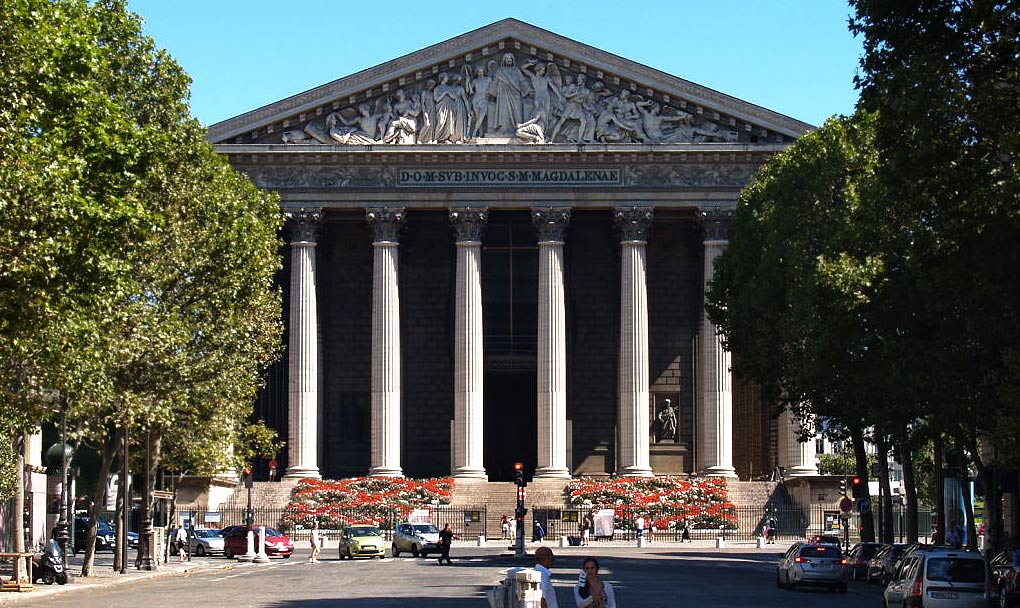
Foto: joz
Para ser una iglesia, la Madeleine tiene sin duda una forma extraña, pues parece más bien un templo de la antigua Roma. La explicación hay que buscarla en la turbulenta historia de París en los años que rodean a la Revolución Francesa.
Historia del monumento
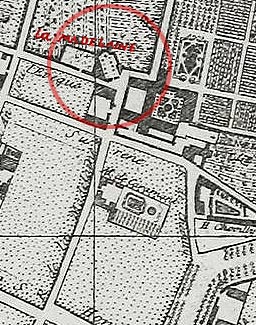
La antigua Madeleine
Antes de que esta zona de la ciudad quedara completamente alterada con la construcción de la enorme Plaza de la Concordia, existía en este lugar una pequeña iglesia de la Madeleine. Pero el diseño de la nueva plaza exigía una iglesia más grande, cerrando la perspectiva de la "Calle Real", que conducía hasta ella.
Cuando estalló la Revolución Francesa, la iglesia se encontraba todavía a medio construir, e inmediatamente se detuvieron las obras.
Pasado el periodo revolucionario, Napoleón quiso convertir la iglesia inacabada en un templo pagano, dedicado a la gloria del Gran Ejército, la Grande Armée. Para ello, derribó todo lo construido hasta entonces, y comenzó a levantarse el edificio que hoy contemplamos.
Pero finalmente, viendo que su efímero Imperio se derrumbaba, decidió que el edificio, ya muy avanzado, volviera a su uso original como iglesia.
Exterior del monumento
La Madeleine tiene la forma de un templo "periptero", es decir, rodeado de columnas por sus cuatro costados, como los templos griegos. Y posee las mismas dimensiones que el mayor templo de la antigua Grecia: el de Zeus Olímpico de Atenas.
Los elementos más destacados en el exterior de La Madeleine son:
1. El frontón
Fue construido después de la Restauración borbónica, en tiempos de Luis Felipe de Orleans, el "rey ciudadano". Aunque Luis Felipe había sido partidario de la Revolución, quiso que la imagen de este gran frontón tuviera un espíritu de conciliación. Por eso permitió que apareciera en él María Magdalena arrodillada ante Jesucristo Juez, como una alegoría de la Francia arrepentida, que suplica perdón por la ejecución de Luis XVI.
En efecto, a pocos pasos de esta iglesia, en la Plaza de la Concordia, había tenido lugar, el 21 de enero de 1792, la muerte del rey en la guillotina.
2. Puertas de bronce
Las puertas de entrada al templo son uno de los elementos más impresionantes de esta iglesia, por sus colosales dimensiones y por la fuerza de sus relieves.
Fueron realizadas por el barón Henri de Triqueti y representan "Los diez mandamientos". Los dos primeros se encuentran en el panel horizontal de la parte superior, y los otros 8 en las hojas de las puertas.
Estos son los mandamientos, y las escenas que los representan. Todas ellas están tomadas del Antiguo Testamento y tienen gran fuerza expresiva.
- "No tendrás otros dioses fuera de mí". Escena que lo ilustra: el pueblo judío recibe las tablas de la Ley.
- "No invocarás en vano el nombre de Dios". El pueblo judío ante Moisés.
- "Santificarás las fiestas". Dios descansa el séptimo día.
- "Honra a tu padre y a tu madre". Noé maldice al hizo que se burló de él.
- "No matarás". Caín es castigado por la muerte de su hermano.
- "No cometerás adulterio". El profeta Natán recrimina al rey David.
- "No robarás". Josué dictando sentencia por un robo.
- "No levantarás falso testimonio". Daniel defiende a la casta Susana ante la acusación injusta.
- "No codiciarás la mujer de tu prójimo". Dios rescata a Sara, la mujer de Abraham.
- "No codiciarás la casa de tu prójimo". Elías recrimina al rey Acab por codiciar la viña de Nabot, y darle muerte.
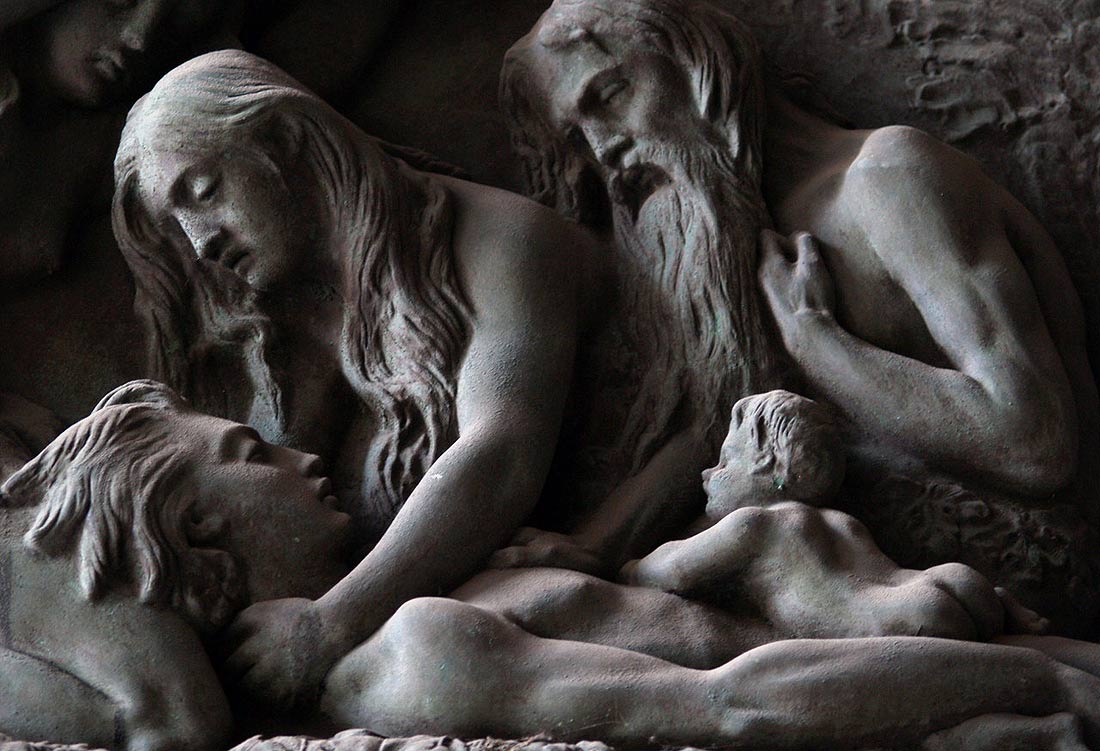
Detalle del 5º mandamiento. Abel yace en tierra tras ser asesinado por Caín. Foto: joz
Visita al interior
Si el exterior de La Madeleine parece un templo pagano de la Antigüedad, el interior se organiza como unas termas, con gran profusión de mármoles de colores.
Su mayor defecto es la escasa luz natural, que deja a la iglesia habitualmente en semipenumbra.
El techo se cierra mediante bóvedas rebajadas, adornadas con casetones y con un gran óculo en el centro, inspiradas en el Panteón de Roma.
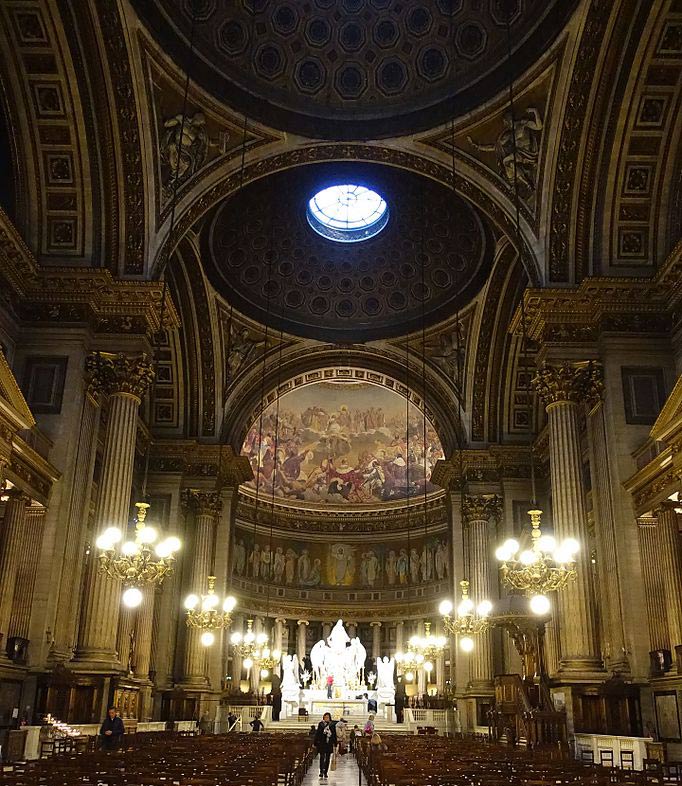
Foto: Guilhem Vellut (recorte)
La iglesia está llena de esculturas realizadas por artistas que fueron los mejores en su momento. El gobierno de Luis Felipe de Orleans puso gran cuidado la decoración de esta iglesia, que debía ser "El Remplo de la Reconciliación nacional", tras las convulsiones de la Revolución Francesa y del Imperio. Por eso destinó a La Madeleine grandes cantidades de recursos.
Las piezas más vistosas son:
- El gran grupo escultórico sobre el altar principal, obra de Charles Marochetti. Se llama "El arrebato de María Magdalena", a la que muestra en éxtasis, en el momento de ser arrebatada al cielo, transportada en una canastilla por ángeles de enormes alas.
-
El enorme fresco de Jules-Claude Ziegler, en el casquete del ábside. En él aparecen representados personajes de la Iglesia, de todas las épocas y culturas. La escena central representa a Cristo, que acoge y perdona a María Magdalena (alegoría de Francia arrepentida, como en el relieve del frontón).
Una banda a los pies de la santa explica el motivo: dilexit multum, amó mucho.
En el fresco aparece también la figura de Napoleón Bonaparte, que en ese momento acababa de fallecer y era extraordinariamente popular en Francia. Clica en la imagen para verlo.
LINKS ÚTILES
https://www.guiapracticaparis.com/la-madeleine.php |
|
|
|
|
|
|
Walter Scott
| Walter Scott |
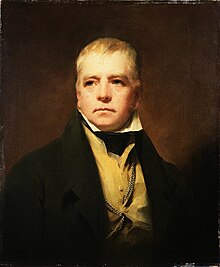 |
| Información personal |
| Apodo |
Border Minstrel  |
| Nacimiento |
15 de agosto de 1771
Edimburgo, Escocia, |
| Fallecimiento |
21 de septiembre de 1832 (61 años)
Abbotsford House, Melrose, Escocia |
| Causa de muerte |
Accidente cerebrovascular  |
| Sepultura |
Abadía de Dryburgh |
| Residencia |
Abbotsford House  |
| Nacionalidad |
Escocia |
| Lengua materna |
Inglés  |
| Familia |
| Padres |
Walter Scott 
Anne Rutherford  |
| Cónyuge |
Charlotte Carpenter (Charpentier) |
| Hijos |
4  |
| Educación |
| Educado en |
|
| Información profesional |
| Ocupación |
novelista, poeta, abogado, Sheriff de Selkirkshire |
| Años activo |
siglo xix |
| Cargos ocupados |
Juez  |
| Movimiento |
Romanticismo |
| Seudónimo |
Jedediah Cleishbotham, Laurence Templeton, Somnambulus, Malachi Malagrowther, Clutterbuck y Lawrence Templeton  |
| Lengua literaria |
inglés |
| Géneros |
Novela histórica, poesía, teatro y Romanticismo  |
| Obras notables |
|
| Miembro de |
|
| Distinciones |
- Baronet
- Miembro de la Sociedad Real de Edimburgo

|
| Firma |
 |
|
|
Walter Scott, primer baronet (Edimburgo, Escocia, 15 de agosto de 1771-Abbotsford House, 21 de septiembre de 1832), fue un escritor británico prolífico del Romanticismo de acción, especializado en novelas históricas, género del que se le puede considerar inventor,1 además de ser poeta y editor. Fue conocido en toda Europa en su época, y, en cierto sentido, fue el primer autor que tuvo una verdadera carrera internacional en su tiempo, con muchos lectores contemporáneos en Europa, Australia y Norteamérica.[cita requerida]
Sus novelas históricas y, en menor medida, su poesía, aún se leen, pero hoy es menos popular de lo que fue en la cumbre de su éxito. A pesar de ello, muchas de sus obras siguen siendo clásicos en la literatura inglesa y específicamente escocesa. Algunos de sus títulos más famosos son Ivanhoe, Rob Roy, The Lady of the Lake, Waverley y The Heart of Midlothian.
Aunque recordado principalmente por sus extensas obras literarias y su compromiso político, Scott fue abogado, juez y administrador legal de profesión, y a lo largo de su carrera combinó su trabajo de redacción y edición con su ocupación diaria como secretario de sesión y alguacil-diputado de Selkirkshire.
Scott, un miembro destacado del establecimiento conservador en Edimburgo, fue miembro activo de la Highland Society, sirvió durante un largo período como presidente de la Royal Society of Edinburgh (1820-1832) y fue vicepresidente de la Society of Antiquaries of Scotland (1827-1829).
Nació en College Wynd, en Edimburgo en 1771; era hijo de un abogado. El joven Walter Scott sobrevivió a un ataque de polio en su infancia que lo dejó cojo de la pierna derecha de por vida. Para restaurar su salud, lo enviaron a vivir durante varios años a la región rural de los Borders (en el sureste de Escocia, fronterizo con Inglaterra) durante siete meses para estabilizar su enfermedad. Allí vivió en la granja de sus abuelos en Sandyknowe. Aprendió el habla de la zona, así como los cuentos y leyendas que caracterizarían gran parte de su trabajo. Su estado de salud motivó también que pasara parte de su infancia en la ciudad balnearia de Bath, en Inglaterra.
Después de estudiar Derecho en la Universidad de Edimburgo, siguió los pasos de su padre y se hizo abogado en Edimburgo. Como empleado de un abogado hizo su primera visita a las Tierras Altas escocesas, para ejecutar un desahucio.
Scott estaba enamorado de Williamina Belsches de Fettercairn, a quien le había propuesto matrimonio varias veces. A pesar de que ella había sido ambigua al contestarle, Scott esperaba que tarde o temprano aceptara. Pero en 1796, Scott se fue a un viaje, y cuando regresó se dio cuenta de que Williamina se estaba enamorando de William Forbes, VII.º baronet de Pitsligo y uno de sus amigos, con quien ella terminaría casándose (más tarde tendrían al científico James David Forbes). Cuando se anunció el compromiso entre Belsches y Forbes, Scott primero se enfadó mucho con ella. Aunque Scott sufrió una decepción amorosa y un sentimiento de dolor que se quedaría en él durante un tiempo, después comprendió que ella no quería hacerle daño.23 Scott seguiría siendo amigo de Forbes, a quien después de morir, aludiría en Marmion,4 y en una carta donde lo describía como un buen amigo.5
|
|
|
|
|
|
 Primer Primer
 Anterior
29 a 43 de 43
Siguiente Anterior
29 a 43 de 43
Siguiente
 Último
Último

|

